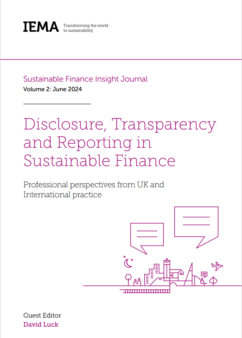In the first part of the journal, the authors discuss the various approaches to reporting in sustainable finance; presenting ideas for now and for the future. Will Goodhart (Chief Executive, of the CFA Society of the UK) considers impact investing and how a theory of change is seeing institutional investors beginning to interpret their fiduciary duties as being wider than just risk-adjusted return alone. Duncan Ball (CEO of BBGI Global Infrastructure) and Cécilia Vernhes (Director of ESG for BBGI Global Infrastructure), present a practical case study of a four-step methodology for climate risk analysis. They examine how the screening of physical climate risks is now systematically integrated into the due diligence and monitoring phases of the investment cycle.
Emilie Goodall (Head of Stewardship Europe for Fidelity International) discusses the nuances of company voting, and the article ranges from the risk that voting bluntly on a shareholder proposal might incentivise a company to spin off a dirty asset just to get it off their books, to how the Fidelity approach is leading to a focus on long-term engagement and system-wide change. David Carlin (CEO of Cambium Global Solutions and Founder of the United Nations Environment Programme Finance Initiative's Risk Centre) acknowledges that while the idea is in its infancy, there is a rising expectation for sustainability claims to be assured. He highlights a strategy to assist the asset management industry in strategically choosing the right funds to meet both their societal and financial goals. Ideas about changing expectations and interpretations of ‘fiduciary duty’ within financial services is picked up again by Donato Calace (Senior Vice President of Datamaran) and Marjella Alma (CEO of Datamaran), who take a deep dive into double materiality and how the concept is shifting the perception of fiduciary duty as well as changing the corporate governance landscape.
The second part of the volume turns to labelling and disclosures. Albert Seoane Miguel (Senior Officer Impact Management and Operations at Innpact) delves into the significance of data quality in carbon footprinting. He uses a simple but splendid example of an airline ticket to illustrate the distinction between using a physical activity-based method and an economic activity-based method, making a compelling case for data quality scoring to understand real outcomes. Nathalie Gaullier (Global Programme Manager of the Global Infrastructure Basel Foundation) and Roger Cruz (Uptake Leader of the Global Infrastructure Basel Foundation) take us through some of the background and detail behind the new FAST-Infra Label, which has been designed as a universal label measuring sustainability and resilience for infrastructure assets.
The next few articles share a common thread: the hot topic of ‘greenwashing’ in sustainable finance, but from different perspectives and across different jurisdictions. Robert Fullerton, (Senior Research Analyst at Hawksmoor Investment Management) reflects on some infamous examples of greenwashing and discusses how in the UK the Financial Conduct Authority (FCA) is implementing its new regulations around Sustainability Disclosure Requirements (SDR) in a bid to combat greenwashing. Valentina Cavanna (Research Fellow at University of Turin and Advisor at ADVANT Nctm) then takes us on a greenwashing deep dive, exploring how the European Union is tackling greenwashing with its Corporate Sustainability Reporting Directives and she introduces the risk of ‘greenhushing’. Lastly, Dr Satoshi Ishihar (Senior Social Development Specialist at the World Bank) looks at greenwashing in emerging and developing markets and asks whether some degree of greenwashing or greenhushing is unavoidable if a company is going to start to move in a more environmentally responsible direction.
In the last article, Paul Flood (Head of Mixed Assets Investment at Newton Investment Management) and Anchit Sharma (Responsible Investment Stewardship Analyst at Newton Investment Management) critique the crucial role of the manager of investment trusts and the role they can play as stewards of investors’ capital. They conclude that a greater diversity of background and a deeper level of operational knowledge could help inform more sustainable decision-making on investment trust Boards.
While this collection of articles covers a lot of technical and practical aspects of transparency, reporting and disclosure in sustainable finance, when read as a whole a picture emerges of a sector using technical and practical tools to strive for a better way of doing things. A hopeful message emerges of the possibilities of positive change through sustainable finance.
Download a copy of the journal here.
Interested in joining the Sustainable Finance Network Steering Group? Click here
Please note: the views expressed in this blog are those of the individual contributing member and are not necessarily representative of the views of IEMA or any professional institutions with which IEMA is associated.


